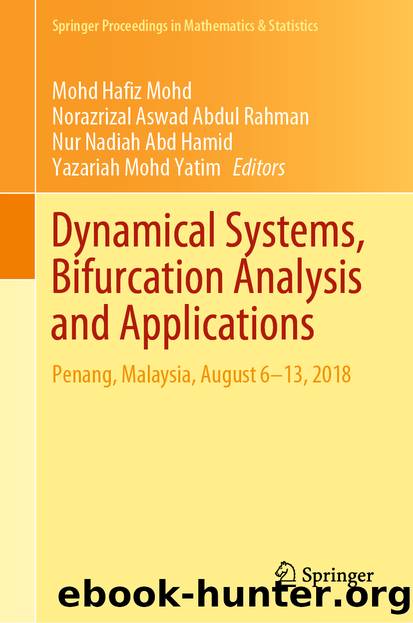Dynamical Systems, Bifurcation Analysis and Applications by Unknown

Author:Unknown
Language: eng
Format: epub
ISBN: 9789813298323
Publisher: Springer Singapore
Keywords
Partial differential equationsNumerical bifurcationStability analysisEcological modelling
1 Introduction
Whether it is down to climate change, invasive species problem or environmental disturbance, species ecosystems across the globe are changing. When this situation happens, some species leave their original habitats in search of a more suitable place where they can live. This process is called dispersal [1]. Apart from dispersal, different ecological forces have been demonstrated to shape species distributions across a geographical region: environmental components (i.e. abiotic factors) [2–5], and species interactions (i.e. biotic factors such as competition) [6–8]. While the influences of competition and abiotic environments are common subjects in the literature [9–13], majority of these ecological studies concentrate on simple two-species systems like in the classical work of Lotka and Volterra [14, 15]. However, real ecosystems in nature consist of complex interactions between multiple interacting species. To better understand the joint effects species can have on one another while living in certain environments, it is crucial to consider an ecological system with more than two-interacting species to mimic the reality. Plus, the interplay of competitive interactions and dispersal process in a multi-species ecosystem with environmental heterogeneity is a complex subject (e.g. refer to [16, 17] for reviews) that needs further studies.
Motivated by these observations, my approach in investigating these ecological issues is by employing a Lotka-Volterra type model consisting of multi-species competitive interactions, which remains biologically relevant and also interesting. To investigate the influences of local dispersal, I incorporate a simple diffusion term and this inclusion leads to a partial differential equations (PDE). I also add a spatial variation in carrying capacity to model changing environments, which can affect the distributions of species. By employing this competitive system, there is a twofold aim of this study. The first is to discuss some techniques in performing bifurcation analysis to examine the dynamics of a PDE system under consideration. Also, the stability analysis of this model is investigated. The second aim is to better understand how these theoretical findings relate directly to the ecological systems; consistent with this aim, I examine the important roles of biotic interactions, local dispersal and environmental components on multi-species community assemblies.
To achieve these aims, I address these ecological problems by extending the deterministic systems discussed in [7, 18, 19] to model competition, environmental factors and local dispersal in multi-species ecosystems. By investigating the findings of the models under various dispersal and competition intensities, I examine the combined influences of local dispersal and species interactions on community dynamics across spatially-varying environments. Additionally, I also employ different methodologies to solve my PDE model with competitive interactions so as to study the combined influences of biotic interactions and dispersal on species biodiversity; to do this, the stability properties of different branches of PDE solutions are analysed using the methods from bifurcation theory and dynamical systems. By considering several dispersal scenarios, I construct some bifurcation diagrams of solution behaviour as the strength of competition is varied using numerical bifurcation analysis in XPPAUT package [20]. This analysis provides a comprehensive way for examining bifurcational changes in dynamics and illustrating different outcomes of species interactions.
Download
This site does not store any files on its server. We only index and link to content provided by other sites. Please contact the content providers to delete copyright contents if any and email us, we'll remove relevant links or contents immediately.
Algorithms of the Intelligent Web by Haralambos Marmanis;Dmitry Babenko(8517)
Building Statistical Models in Python by Huy Hoang Nguyen & Paul N Adams & Stuart J Miller(7276)
Azure Data and AI Architect Handbook by Olivier Mertens & Breght Van Baelen(7274)
Serverless Machine Learning with Amazon Redshift ML by Debu Panda & Phil Bates & Bhanu Pittampally & Sumeet Joshi(7160)
Data Wrangling on AWS by Navnit Shukla | Sankar M | Sam Palani(6925)
Driving Data Quality with Data Contracts by Andrew Jones(6904)
Machine Learning Model Serving Patterns and Best Practices by Md Johirul Islam(6650)
Learning SQL by Alan Beaulieu(6151)
Weapons of Math Destruction by Cathy O'Neil(6073)
Big Data Analysis with Python by Ivan Marin(5677)
Data Engineering with dbt by Roberto Zagni(4668)
Solidity Programming Essentials by Ritesh Modi(4331)
Time Series Analysis with Python Cookbook by Tarek A. Atwan(4171)
Pandas Cookbook by Theodore Petrou(3897)
Blockchain Basics by Daniel Drescher(3418)
Hands-On Machine Learning for Algorithmic Trading by Stefan Jansen(2952)
Natural Language Processing with Java Cookbook by Richard M. Reese(2898)
Feature Store for Machine Learning by Jayanth Kumar M J(2856)
Learn T-SQL Querying by Pam Lahoud & Pedro Lopes(2841)
